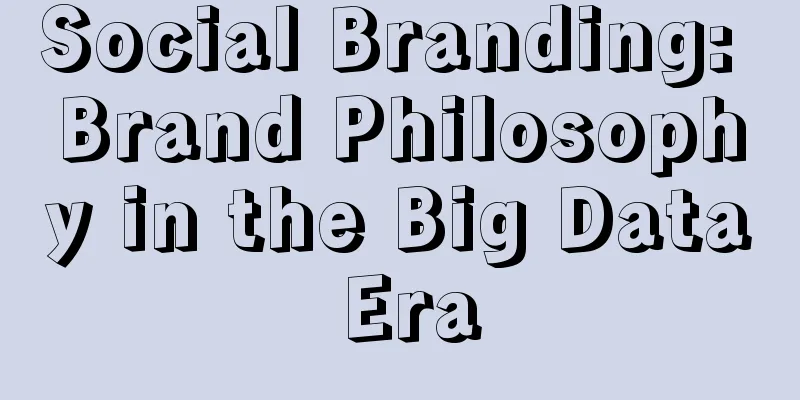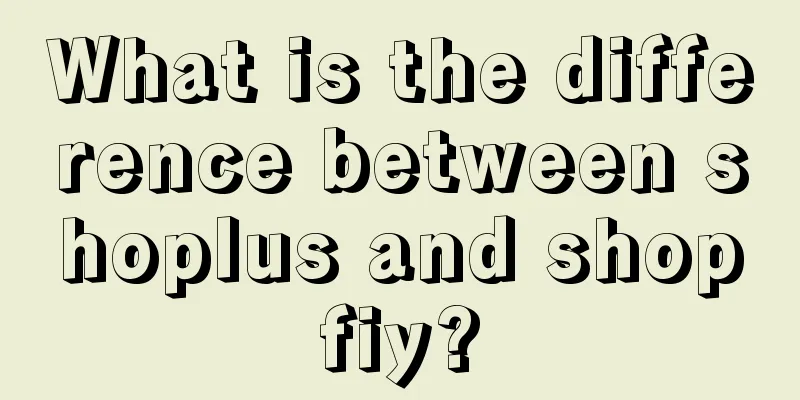Social Branding: Brand Philosophy in the Big Data Era

The fundamental difference between traditional marketing and modern marketing is that traditional marketing is based on psychology, while modern marketing is based on behavioral science. In the past, in order to influence consumers’ decision-making process, the marketing industry mainly focused on various psychological variables, such as cognition, attitude, emotion, learning, and memory, which led to various marketing theories. For example, brand theory focuses on influencing people’s attitudes and emotions, while positioning theory focuses on influencing memory structures. The most classic consumer link model AIDMA divides people's decision-making into five stages: attention, interest, desire, memory, and purchase. The first four of these are psychological variables, and only the last one is a behavioral variable. Now, with the empowerment of digitalization, the marketing industry pays more attention to various behavioral variables. For example, AISAS, the consumer model of the Internet era. In this model, only the first two attention and interest are psychological variables, while the last three search, purchase, and share are behavioral variables. The growth hacker model AARRR that has emerged in recent years has taken a step further. Compared with all previous consumer models, whether AIDMA, AISAS, SIPS, AIPL, 5A, etc., the most essential difference is that each link of AARRR is a behavioral variable. Acquisition is a behavior, activation is a behavior, retention is a behavior, revenue is a behavior, and referral is a behavior. Since it is a behavior, it means that every step in the relationship between the brand and the consumer can be quantified through data, so that consumers can be understood and controlled more accurately, and precise direction and guidance can be provided for brand marketing. From an academic perspective, psychology and behavioral science have very close connections and intersections, and the behavioral school itself is also a school of psychology. But from a marketing perspective, the biggest difference between behavioral variables and psychological variables is that behavior is an objective existence that can be quantified, while psychology is an elusive subjective conjecture. Behavior can be directly reflected in data, while psychology can only be inferred through questionnaires, consumer interviews, and behavioral data. For example, if a person likes to party and participate in various social activities (behavior), then you can infer that this person is extroverted, confident and sunny (psychology). As the saying goes, it is difficult to draw the bones of a dragon or a tiger, and you can know a person's face but not his heart. As the saying goes, lust is the root of all evil, and judging by deeds rather than the heart, there is no perfect person in the world. If you want to judge whether a person is lustful, instead of guessing what he thinks all day, it is better to look at his web browsing data. It is more reliable and accurate to understand a person through his behavior than through his psychology. It is better to observe his actions than to listen to his words. Behavior is explicit, while psychology is implicit. Behavior is a direct variable, while psychology is an indirect variable. We know that today is an era that requires data. The essence of big data is behavioral statistics. We collect and summarize a large amount of people's behavioral data, observe and analyze the correlation between people's different behaviors, and explore the causal relationship behind them. Today, when we do marketing, we talk about precision and quantification of results. All of this is based on measurable consumer behavior, which was impossible in traditional times. Like the growth hacker we mentioned earlier, its core methodology is AB testing + data verification . First test, then compare the data performance of consumers in the five links of AARRR to verify the accuracy of product design and marketing promotion, and continuously optimize product and marketing effects. I still remember having dinner with a friend who is the strategic director of Blue Label Group in 2018. At that time, we talked about how more and more companies are setting up CGOs and growth departments and trying to replace traditional marketing and brand management departments. So how to combine the two, using brand methods to achieve growth and using growth technology to build brands, has become a topic worth discussing. Nowadays, data and technology are increasingly integrated into user operations and brand management, and brands and growth are becoming increasingly integrated. I believe that consumer behavior is the key and connecting point. The parent disciplines of marketing are economics and social behavior (and psychology). Economics is the father of marketing, and social behavior is the mother of marketing. Most of the marketing theories we know today are based on psychology, but I believe that future marketing theories must be based on behavior. This shift from psychology to behavioral science has led to major changes in the way brands are built. Brand building in the traditional era comes from the packaging of things. We package products with a name, a trademark, a symbol; a selling point, a positioning; an image, a story, a cultural value. We try to integrate psychological added value such as attitude, emotion, and personality into physical products, so as to win consumers' recognition and purchase, and make the products generate premiums. Brand building in the digital age comes from the operation of people. The various concepts and marketing tools we often talk about today, such as scenarios, communities, fans, interactions, private domains, and traffic pools, all start from how to connect with consumers and build relationships. If you can circle a group of users, then in theory you can sell them anything you want. And when you build a relationship with consumers, they will spontaneously fall in love with you, support you, and advocate for you. I call this way of establishing direct connections with consumers, turning them into fans, and building brands through user management a social brand . Some people may think that social brand refers to private domain operation. It is necessary to clarify here that, based on the concept of social brand, all goals of brand communication and marketing promotion are to penetrate consumer behavior and establish relationships with consumers. Private domain operation is not just about selling goods in groups, but about managing users. Let’s look at an example. In recent years, the halos of brands such as Nike and Adidas seem to be fading. The fate of Reebok, another well-known sports brand once owned by Adidas, is even more miserable. Reebok once occupied the top spot in the global sports shoe brand and has a glorious history. It invented the world's first pair of spiked running shoes and inflatable sports shoes. In the 1980s, disco was all the rage around the world, and aerobics was in the limelight. Reebok launched the first pair of women's aerobics shoes (called Freestyle), and sold 30,000 pairs in the first month. Oscar-winning actresses wore them to aerobics classes, and popular actresses wore them on the Emmy Awards red carpet. Reebok thus became the latest fashion leader and a household name in the United States. In 2005, Adidas spent 3.8 billion US dollars to acquire Reebok in order to compete with Nike for the US market. Reebok has since become a stepping stone for Adidas to rise to the top. In order to help Adidas occupy the US market, Reebok gave Adidas the three major US event resources it sponsored, NBA, NFL, and NHL. In addition, Reebok and Adidas have similar brand strategies, and they fought each other in the market, and Reebok has since declined. In 2014, in order to revive the Reebok brand, Adidas designed a new brand strategy for Reebok: focusing on the fitness market. In my opinion, this is a great strategy. First, fitness is sweeping the world, and the market prospects are broad. Fitness brands such as UA and lululemon are growing rapidly. Second, Reebok focuses on fitness and no longer conflicts with Adidas. They are both doing well and making their own efforts. Third, the fitness strategy taps into the brand history and genes of Reebok in the past, returning to the advantage point when it was founded. Under the guidance of the new strategy, Reebok began to launch a new brand marketing—— 1. Update the brand logoThe new LOGO is more vivid and powerful, symbolizing the physical, spiritual and social changes that fitness brings to people, and is more in line with the fitness market strategy. (Old LOGO) (New LOGO) 2. Develop new channelsReebok has signed contracts with several gym chains to carry out brand communication in the gyms and cooperate in developing fitness courses. 3. Signing a new spokespersonIn early 2017, Reebok signed Wang Deshun, Yuan Shanshan and Wu Lei as brand ambassadors for Greater China. Yuan Shanshan is a famous "six-pack goddess" in China, who successfully reversed her online reputation through fitness; Wang Deshun, who can still walk on the catwalk shirtless at the age of 79, is a fitness legend for the elderly. The choice of these two spokespersons is great, perfectly reflecting the brand concept and image of fitness. Wu Lei is like a supplement to traffic, popularity, and the capture of the young consumer market. 4. New Communication ThemeIn early 2015, Reebok launched the largest brand communication campaign in the company's history in the past 10 years, and also invested in the Super Bowl advertisement, which is known as the "American Spring Festival Gala". The theme of this round of campaign is called "Be More Human", which is translated into "Refine to Me" in China. It means to discover your own limits and become a stronger self. At the same time, Reebok also launched a short advertisement called "25915 Days". 25915 days is the average time an ordinary person spends in this world. The World Health Organization has calculated that the average life expectancy of the global population is 71 years old, which is equivalent to 25915 days. Reebok raised a question: How should we live in these 25915 days? It focuses on an elderly grandmother and uses a rewinding shooting technique to review her life of running, from participating in the Reebok Marathon in her old age, to rushing to run on the street with a baby stroller when she was a new mother, to running with her friends in underwear in college to show off her youth, to participating in long-distance running in school sports meets in elementary school, and all the way back to the scene when she was just born in her cradle. However, Reebok was not resolute in implementing its fitness strategy. Later, Reebok invited supermodel Gigi Hadid, rapper Kendrick Lamar, and Korean girl group BLACKPINK to endorse its products, promoting co-branded trendy shoes and street culture. It also changed its brand proposition to "Sport the Unexpected" (translated as "Dare to be an exception" in China) to emphasize individuality and uniqueness. Its domestic advertising also used popular celebrities to endorse its products to promote individual trends. This seems to be completely incompatible with the spirit of fitness, has no spiritual connotation at all, and is really vulgar. Moreover, this strategy of being caught between two sides is not popular. It completely deviates from the overall brand strategy of fitness and looks like a poor imitation of Adidas' fashion strategy. In fact, Reebok’s advertisements should be passionate, inspiring, and stick to the point. It should constantly look for ordinary people who train hard and strive to surpass themselves, dig out their stories to spread, shape the brand culture, and infect more fitness enthusiasts, instead of releasing sweet videos about fashion idols and street trends. What is the difference between you and other sports brands? Will those who sweat in the gym and set strict standards for themselves be moved by these things? When Adidas' new CEO took office in 2016, he made a five-year plan for Reebok, aiming to return to profitability in 2020. But in fact, after a brief recovery in early 2019, Reebok began to decline again in 2020. Adidas, losing patience, sold Reebok in August 2021. It bought for $3.8 billion and sold for $2.5 billion. This is the story of Reebok. In fact, Reebok's failure was not due to the wrong direction of its fitness strategy, but rather to outdated and distorted practices in the process of implementing its fitness strategy. As a fitness brand, let's take a look at how lululemon built its brand. Founded in 1998, lululemon has now become the world's second largest sports brand. Lululemon does not have a marketing department, rarely advertises, and has never hired big brands as endorsements. So what is it relying on to achieve growth? In particular, its flagship product, yoga pants, sells for about 850 yuan, more than twice the price of similar products from Nike, Adidas and other brands. The answer is the user strategy, store strategy and brand strategy designed by lululemon. Lululemon has built a systematic user community, which is spread through product educators, brand ambassadors and user groups . Lululemon calls all its employees product educators, requiring them to be familiar with products and businesses like experts, so as to educate users well. When recruiting store managers, lululemon gives priority to people from the news and coffee industries rather than those with a retail background, because lululemon believes they are better at accepting and spreading brand culture. Lululemon even encourages executives and employees to take a mind-opening course called "landmark" to stimulate their "real potential." The purpose of all this is to better spread the brand culture. In the end, lululemon's black pants transcended the product itself and were given a greater meaning. Not only did they change from professional fitness scenes to women's daily clothing, but they also became a symbol of women's awakening consciousness. On the other hand, every time it enters a city, lululemon will dig out the 20 most popular local fitness coaches, yoga teachers, and dance teachers. From these candidates, lululemon will eventually select 4-5 winners as store ambassadors. The store will provide ambassadors with free clothing, design courses for them, and shoot promotional videos and photos for them; it will hang posters of them wearing lululemon products in the store; it will also put their promotional photos in local newspapers and indicate the name of the ambassador's yoga studio. In this way, brand ambassadors can guide traffic to stores. As a highly educated elite group, ambassadors wear lululemon to show off their toned bodies and smooth muscle lines, which is the best advertisement for the brand and has a strong demonstration effect on ordinary consumers. In addition, brand ambassadors will work with each store team to establish promotion strategies through events, communities and social media to help the brand radiate among fitness enthusiasts in the local community. At lululemon's annual event Sweatlife every year, the main content is fitness KOLs sharing their fitness experiences and lifestyles, and the new product launch is an optional additional session. With the support of this user strategy, each store of lululemon has become a user base. Every time a store is opened, lululemon will do four things first: 1. Pop-up store preparation: First look at a low-cost pop-up store to prepare for the early stage of user development 2. Invite potential users: Invite target users to the store to take yoga classes and try on new products through an invitation system 3. Connect with local yoga studios and brand ambassadors: Rely on brand ambassadors and product educators to stimulate word-of-mouth social marketing and penetrate surrounding sports and fitness venues 4. Open a physical store: When the time is right, open a flagship store in the CBD area of the city All of lululemon's stores are directly operated. The stores have great power. How to organize user activities and shape the sports atmosphere is entirely up to the stores, and the headquarters does not interfere. The user activities held by the stores are highly vertical to the community, not overly commercialized, and do not promote products to users on site. The average budget for an event is only 3,000 yuan, but the proportion of on-site shopping is as high as 98%. This became the essence of lululemon's growth in the early years. Today, Nike and Anta are learning lululemon's DTC model, drastically reducing dealers, increasing directly-operated stores, and fully empowering stores, allowing stores closest to consumers to make decisions. Based on this user and store operation strategy, we can see that lululemon has gone through the process of " niche group loyalty → reputation formation → popularity expansion " in brand development. First focus on the community, and through interaction with these users and word-of-mouth spread, it will eventually become a well-known social brand. Community, social networking, and society are the growth path of a social brand. Comparing Reebok and Lululemon, we can see that Reebok still has the high-profile path dependence in the process of brand building, relying on big-name celebrity endorsements and high-end advertising to build its brand. Lululemon adopts a decentralized and distributed operation strategy, aiming to establish a deep relationship with consumers. Reebok is an approach in the centralized media era, while lululemon is a choice in the social era. In the past, brand communication was mainly to promote a concept or a slogan, win the recognition of consumers, influence their attitudes and emotions, and impress them to buy. Now, brand communication is actually to directly appeal to consumer behavior and establish user relationships. Through behavior and relationships, it in turn influences consumer attitudes. This involves a psychological issue: does attitude determine behavior, or does behavior determine attitude? In the past, we believed that attitude determines behavior. If a person's attitude changes, his or her behavior pattern will naturally adjust. Therefore, when building a brand, we emphasize the importance of establishing a brand image, conveying consumer attitudes, emotional appeals, and forming cultural identity. We do everything we can to make consumers fall in love with the brand, so that they choose to buy and form a loyal purchasing habit. First build reputation, then build loyalty. But in fact, we found that it is very difficult to make consumers fall in love with a brand. Consumers today are not willing to love people, so how can they love a brand? Moreover, the human mind is very stubborn, and attitudes will not change easily. It is difficult to educate consumers. We always subconsciously resist information that tries to show that we have changed. Moreover, American psychologist William James found that 99% of our behaviors are purely spontaneous activities, which do not involve conscious attitudes and motivations. In other words, most of our behaviors are not determined by deliberate attitudes, but conditioned reflexes influenced by the environment. When we have a certain behavior, we will form a corresponding attitude to be consistent with the behavior and cognitive coordination. In other words, we are looking for a rational explanation for our behavior. For example, I plan to run, but I can't get up in the morning and don't run. At this time, I will convince myself that life lies in stillness, which is an excuse for laziness. It is not attitude that changes behavior, but behavior that changes attitude. Here I can share with you a little life tip. If you make yourself laugh often, it will be easier for you to stay in a good mood. The goal of brand communication is not just to spread an idea or slogan, but to influence actions. Compared with the functional, emotional, and value-oriented approaches that try to persuade consumers and make them fall in love with the brand, brand social networking and private domain operations directly start from consumer behavior and are more fundamental. Gabriel Tarde, one of the three founders of French sociology, has a classic assertion: communication is imitation . He used the two factors of invention and imitation to explain all social life phenomena, and believed that human society is a cycle of invention, imitation, conflict and adaptation. Someone invented new ideas, new concepts, new technologies, and new products, which then triggered imitation by the masses. In the process of innovation diffusion, it conflicts with people's inherent cognition and traditional habits, and eventually forms adaptation. Imitation is the soul of social life, the most basic social phenomenon, and the ultimate element of social behavior. Human beings are a group of individuals who imitate each other, and our society is composed of the spread and exchange of personal emotions and ideas caused by imitation. The relationship between people is mainly a relationship of imitation. Therefore, Tarde said that imitation is communication. This sentence explains how advertising and brand communication work on consumers and help sales. The ultimate goal of a company's brand communication is to get consumers to imitate the characters and behaviors in the advertisements and buy and use the products. The ultimate goal of communication is to form consumers' imitation from concepts, words to behaviors. The brand is passed on by word of mouth, and groups of people consume and use a certain brand. In order to make people imitate, the key is to implant memes in brand communication. Memes are replicators in social culture, which are transmitted through non-genetic means, that is, imitation. Putting aside the academic definition of "meme", I personally understand meme as the motivation for imitation. The English word "meme" is imitated from the word gene. My understanding of it is the replication and transmission from one me to another. A meme can be a melody, an idea, a story, a game, a slogan, a style of clothing, a life skill and habit. Anything that is passed from one person to another in the form of imitation is a meme. The reason why the public imitates is mainly because of the promotion of memes. The mission of social brands is to imitate, and the means is memes. In marketing communication, what kind of memes are easy to spread among the crowd and influence consumer behavior? For example, a red wine brand can flaunt its image and grade in brand building, and shape itself into an elegant, romantic, and high-taste lifestyle. This is what we often call lifestyle marketing. But this marketing method is usually difficult to work. First, it is difficult to convince consumers. Once again, it is difficult to change consumers’ inherent ideas. Second, “lifestyle” is too empty and abstract, and consumers don’t know how to copy this lifestyle into their own lives. So you have to provide consumers with more specific behavioral instructions, such as cooking red wine. Recently, a large number of bloggers have shared videos and pictures of themselves cooking red wine on social media, and told everyone that this is the most popular and IN lifestyle for contemporary fashionable young people. Cooking red wine represents a certain sense of ritual and small happiness in life. As a result, cooking red wine has attracted a large number of users to imitate it, and it has even become a trend. Those who originally had no habit of consuming red wine will also become interested in trying it and add red wine into their lives. Cooking red wine is a meme. With a meme, consumers know how to imitate it. Susan Blackmore, author of The Meme Machine, defines a meme as " an instruction to perform a behavior that is stored in the brain and spread through imitation ." Memes are best to be behavioral instructions, so that they can be easily copied among the crowd. Today, various content seeding on social media is mainly through lifestyle demonstrations to influence others to imitate. For example, C in the morning and A in the evening, camping, and plain water makeup are all memes. Good lifestyle marketing must be injected with memes. In the above content seeding, another indispensable point is the demonstration role of KOL. Tarde summarized the laws of imitation, the first of which is called the law of descent . This means that imitation is often from top to bottom, and low-status classes and individuals always imitate high-status classes and individuals. This is imitation that radiates from high to low. The second law of imitation is called the law of first the inside and then the outside . It means that imitation is from the inside to the outside. Any imitation behavior is first ideological imitation, then material imitation. The spread of ideas precedes the spread of expression. Therefore, in order to form imitative social behavior, ideas and concepts must come first. Many mature big brands will do value marketing, appealing to a cultural value and life attitude. In fact, the purpose of value marketing is not to make consumers fall in love with the brand and establish emotional connections, but to influence consumer behavior and form large-scale imitation at the social level. For example, Nike's "JUST DO IT" and keep's "Self-discipline gives me freedom" can form consumer behavior imitation, while simply promoting passion and being yourself will not have this effect. In order to facilitate replication and imitation, memes in brand communication should be committed to responding to the relationship between people and society. Because people are born social animals, socializing is human nature. Adler, the founder of individual psychology, believes that the three major issues that people must face in life are work, socializing, and gender. In fact, aren’t work relationships and relationships between men and women also social? So there is only one problem that we must face in life, and that is social relationships. Only when brand communication involves content related to social relationships such as how we view ourselves, how we view work and family, how we view gender and love and marriage, how we view the country and the world, etc., can such communication attract the attention and discussion of the public. Once social imitation is formed, it can grow exponentially and spread rapidly without interference. This can explain what we call fission and exponential growth today. Imitation has great social power. This is the third law of imitation, the geometric rate. For example, KFC's Crazy Thursday has now become a national carnival. Countless consumers create various jokes for it and spread them widely on social media. Every Thursday, various WeChat groups are full of Crazy Thursday jokes. For brand marketing, memes can help brands become a popular culture. Today is an era of big explosion. There is a big explosion of products, information and data... In the past, products were relatively scarce. As long as the quality of enterprise products was acceptable and they had a certain degree of popularity, the general public would pay for them and think that you were a big brand and trustworthy. However, with the abundance of products today, there are plenty of brands to choose from, regardless of the category. In this case, if a brand wants to stand out, it must have distinct characteristics and differentiation to create a unique experience for consumers. In the face of the product explosion, the most important thing for a brand in its early stages is to strengthen the experience and shape the brand with experience. Secondly, there is the explosion of information. In the past, when information was scarce, advertising bombardment was very effective. If a slogan became a popular golden phrase, it could ensure that the brand would sell well for many years. But today, the cost of advertising bombardment is extremely high, and it is difficult to break through the platform barriers and consumer cognitive barriers. In the age of information overload, brands must label themselves and maximize the concentration of brand information with the lowest communication cost, so as to form an impression in the hearts of consumers and break through the circle through labels. In the face of information explosion, the most important thing for a brand in its growth stage is to label and build cognition with labels. Finally, there is the explosion of data. With the empowerment of big data, we can more accurately control consumer behavior and more easily establish connections and relationships with consumers. This is the ultimate goal of brand marketing. Faced with the data explosion, the most important thing for a brand in its mature stage is to socialize with consumers and strengthen relationships through social interaction. A unique brand experience represents the height of a brand, its professionalism and appeal to consumers. Brand labels represent the breadth of a brand, its coverage, influence and activity in consumers’ minds. Social and relationships represent the depth of a brand, the interactivity and relationship that consumers have with the brand. Experience brand, label brand, social brand, this is my original brand thinking and also the brand philosophy of the big bang era. References: [1] “12,000-word analysis of lululemon: a combination game of “wizard” and “hedgehog””, source: WeChat public account Growthbox, 2022-01-11; Author: Kongshou; WeChat public account: Kongshou |
<<: With over 700 million views, why are “awkward” street interviews so popular?
>>: Douyin instant retail brings in a “new ally”
Recommend
Q1 financial report reveals the “wolf nature” of video accounts: user time increased by 80%, and merchants entered the market on a large scale
This article specifically introduces the current s...
How long does it take to review Amazon brand registration? What information does Amazon require?
Nowadays, everyone wants to open a store on Amazon...
Dingdong Maicai launches the "Nutritional Choice" label, and the trend of beverage ingredients has finally reached e-commerce
Recently, Dingdong Maicai officially launched the ...
What is the Amazon Japan support package for new sellers?
Starting from March 1, 2022, Amazon will once agai...
What to do if Amazon has no traffic? How to get it?
Today I will introduce to you how to open a store ...
Merchants pressed by "refund only" policy
When a product has loopholes, there will be people...
Copy homework! Teach you how to build an operations analysis system step by step
The analysis of a single operational action is cer...
This generation of elderly people loves "script killing" live broadcast
This article starts with the "script-killing&...
How to start Amazon Logistics Remote Delivery Program? What is the method?
Merchants who open stores on Amazon need to select...
It’s not easy for Meituan to become an outdoor media company | Outdoor Advertising Observation
The creation and operation of ladder media has alw...
Brand No. 1, don’t forget the basic probability when building a brand
Nowadays, there are more and more new consumer bra...
Pinduoduo operation skills
This article shares some Pinduoduo operation skill...
What did ClickUp do right to achieve 150 million ARR in 6 years in the red ocean market?
Mumu is a writer who started out as a software en...
How often are Amazon account ratings updated? Why do Amazon rankings drop?
For Amazon merchants, there are many things that n...
How can I have my own methodology when working in a small factory?
Students working in small factories always envy th...









